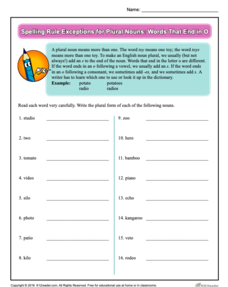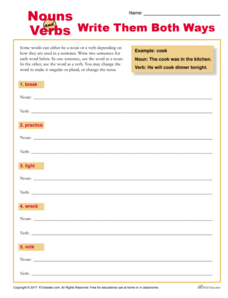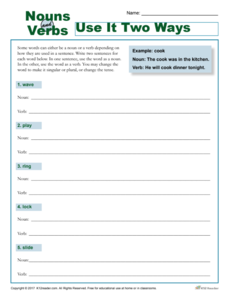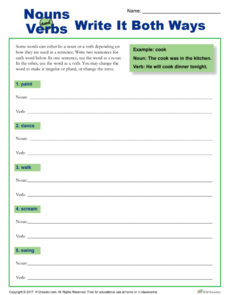K12 Reader
Spelling Rule Exceptions for Plural Nouns: Words That End in O
Why do heroes and photos end in different ways? Learn the differences among different words that end in -o with a grammar exercise worksheet.
K12 Reader
Spelling Rule Exceptions for Plural Nouns: Words That End in CH and SH
Have you done the dishes? Or closed the hatches? A practice worksheet invites learners to check 20 words with different endings, and to add either -s or -es to each.
K12 Reader
Plurals: Nouns and Verbs Ending in Y
If a word ends in -y, to make it plural you change it to -es, right? Not always! Use a activity that addresses both nouns and verbs that end in -y and prompts learners to follow the grammar rule when changing each word.
K12 Reader
Find the Pieces: Predicate Adjective, Noun and Verb
This activity is helpful! Young grammarians review ten simple sentences, each with a subject, linking verb, and predicate adjective, before noting each part of speech appropriately.
K12 Reader
Nouns Verbs: Write it Both Ways
A worksheet gives scholars the opportunity to take five words and use them as a noun and a verb. Changing the verb tenses and making nouns singular or plural work to compose a grammatically correct sentence.
K12 Reader
Nouns Verbs: Use It Two Ways
Scholars show what they know about nouns and verbs in a worksheet that requires them to read five words then use them in two sentences—as a noun and a verb.
K12 Reader
Find the Abstract Nouns
A worksheet challenges scholars to read 20 words then identify and circle the 11 abstract nouns.
K12 Reader
Missing Nouns
Scholars use nouns from a word bank to complete sentences in a fill-in-the-blank instructional activity that tells a tale about the California Gold Rush.
K12 Reader
Change the Nouns to Adjectives
A 10-item practice page requires scholars to change nouns to adjectives by adding the appropriate suffix.
K12 Reader
Guess a Noun
Can you figure it out? A worksheet challenges grammarians to read 28 descriptions and guess what noun each one is describing.
K12 Reader
Sentence Writing: Conjunctions!
You don't need to be a grammar fan to use FANBOYS correctly—but it helps! Practice using conjunctions with a word bank of common connecting words and eight sentence prompts.
K12 Reader
Conjunctions: Connecting Predicates
Forget walking and chewing gum—the subjects of these sentences can perform several actions at once! Practice connecting predicates with conjunctions in a helpful grammar worksheet.
K12 Reader
Conjunctions: Connecting Subjects
Having two subjects seems like it makes a sentence more complicated, but it's as easy as adding an extra conjunction! Connect subjects with eight sentences that are each missing an important and.
K12 Reader
Conjunctions: Connecting Modifiers
Practice grammar and come up with some great sentences! Language arts students find the missing and in each sentence with a worksheet that focuses on conjunctions.
K12 Reader
Correlating Conjunctions
A worksheet on correlating conjunctions could be used as either a check for comprehension or as a homework assignment. Whether or not conjunctions are their thing, the activity will not only engage young grammarians, but also teach them...
K12 Reader
Nouns Verbs: Write it Both Ways
A five-item worksheet challenges scholars to write two sentences using the same verb in two different ways—as a noun and a verb.
K12 Reader
Writing with Interjections
Challenge young writers to craft original sentences using interjections from a list provided on a colorful worksheet.
K12 Reader
Mild and Strong Interjections
Whew! This worksheet is tough! Unless, of course, young grammarians know the difference between mild and strong interjections.
K12 Reader
Interjections in Dialogue: Tom Sawyer
Mark Twain is a master of using interjections in his dialogue. A grammar worksheet focused on interjections features the passage from The Adventures of Tom Sawyer in which Tom tricks Ben into taking on the job of whitewashing Aunt...
K12 Reader
Find the Interjection
Yikes! Young grammar sleuths must find the interjections that add the oomph to a series of sentences.
K12 Reader
Add an Interjection
Wow! Here's a instructional activity about interjections! After reading a brief definition of this part of speech, young grammarians select an interjection from the provided word bank to add to a sentence.
K12 Reader
Which Is It: Subordinating or Coordinating Conjunction?
To demonstrate their understanding of the difference between subordinating and coordinating conjunctions, learners identify and label the conjunctions found in 10 sentences.
K12 Reader
Spot Them! Correct Conjunctions
Young grammarians demonstrate their understanding of conjunctions by identifying sentences on a short worksheet that use conjunctions correctly.
K12 Reader
Correcting Run-On Sentences: Commas and Conjunctions
Young grammarians learn how to correct run-on sentences by adding coordinating conjunctions and commas.

























